Employment gap background check procedures have evolved to reflect modern workforce patterns, including gig work, freelancing, and career breaks now considered standard. Organizations conducting job history verification must balance thorough screening with understanding legitimate employment timeline gaps while maintaining FCRA compliance and avoiding discrimination.
Key Takeaways
- Employment gaps in background checks are periods of unemployment lasting typically 30 days or longer that appear during job history verification processes.
- Modern background screening recognizes gig economy work, freelancing, caregiving responsibilities, and educational pursuits as legitimate reasons for employment timeline gaps.
- FCRA compliance requires employers to provide adverse action notices when employment gaps influence hiring decisions, giving candidates an opportunity to explain circumstances.
- Adjudication guidelines should focus on relevance, recency, and severity of gaps rather than applying blanket disqualification policies.
- HR professionals must document gap explanations and maintain consistent evaluation standards across all candidates to avoid discrimination claims.
- Technology solutions now help automate gap detection while allowing human reviewers to apply context-appropriate judgment during adjudication.
Understanding Employment Gaps in Background Screening
An employment gap background check examines periods when candidates were not engaged in traditional full-time employment. These gaps appear as breaks in the employment timeline during job history verification. They typically range from one month to several years. Background screening companies identify these periods by comparing reported employment dates against available records from previous employers, tax documents, and professional references.
Employment gaps have shifted dramatically in significance. According to 2024 workforce analytics, approximately 62% of American workers have at least one employment gap of three months or longer. This reflects changing career patterns including voluntary career breaks, pandemic-related layoffs, and non-traditional work arrangements. Economic uncertainties have made employment interruptions more common across all industries.
Modern screening practices recognize that gaps don't automatically indicate problems. Adjudication focuses on understanding the nature and context of these periods. Staffing agencies and hiring managers evaluate whether gaps involve legitimate activities including education, caregiving, health recovery, or entrepreneurial ventures. They assess these breaks in context rather than viewing all unexplained periods as red flags.
Why Employment Timeline Gaps Occur in Modern Workforce
Career development patterns have fundamentally changed from linear progression that characterized previous generations. Today's professionals frequently pause traditional employment for legitimate reasons. These breaks often enhance rather than diminish their value as candidates.
Common reasons for employment timeline gaps reflect changing workforce dynamics:
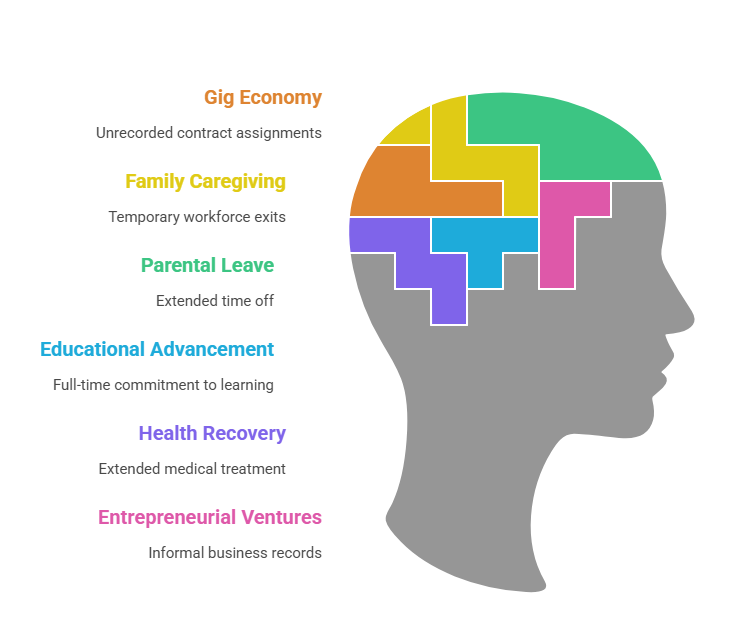
- Gig economy participation: Contract work, freelancing, and project-based assignments through platforms like Upwork or Fiverr that don't appear in traditional databases.
- Family caregiving: The Census Bureau reported in 2024 that approximately 14 million Americans serve as primary caregivers requiring temporary workforce exits.
- Parental leave: Extended periods beyond employer-provided benefits reflecting personal priorities.
- Educational advancement: Pursuing degrees, certifications, or training programs requiring full-time commitment.
- Health recovery: Medical conditions requiring extended treatment or rehabilitation.
- Entrepreneurial ventures: Starting businesses that may not have generated formal payroll records.
These legitimate gap categories increasingly represent normal career patterns. The 2020-2023 pandemic period further normalized career gaps by creating involuntary employment disruptions for millions of qualified candidates.
Legal Framework Governing Gap Adjudication
FCRA Requirements for Background Check Decisions
The Fair Credit Reporting Act establishes strict protocols when employment gaps influence hiring decisions. Employers must provide pre-adverse action notices before rejecting candidates based on background check findings including employment timeline gaps. The notice must include a copy of the background report and summary of FCRA rights. It must give candidates at least five business days to dispute inaccuracies or provide explanations.
When candidates offer legitimate gap explanations, employers must consider this information before final decisions. Documented caregiving responsibilities, verifiable freelance work, or educational transcripts all qualify as relevant information. The individualized assessment requirement means organizations cannot automatically disqualify candidates based solely on gap duration. Documentation of this evaluation protects employers from discrimination claims while ensuring fair treatment.
Anti-Discrimination Protections
Title VII of the Civil Rights Act intersects significantly with employment gap adjudication. Policies that disproportionately exclude candidates with employment gaps can create disparate impact against protected classes. Women, who statistically take more career breaks for caregiving, face particular vulnerability. Similarly, gaps related to disability recovery, religious observances, or pregnancy must receive careful evaluation.
The EEOC issued updated guidance in 2024 emphasizing that blanket policies may violate anti-discrimination laws. These policies reject all candidates with gaps exceeding certain durations without individual consideration. HR professionals must evaluate gaps individually, considering legitimate explanations and focusing on job-relevant factors. Organizations need flexible policies rather than inflexible rules.
Best Practices for Conducting Job History Verification
Comprehensive employment verification begins with clear candidate communication about the screening process. Application materials should request complete employment history, explicitly including part-time work, contract positions, and self-employment. Providing space for gap explanations on initial applications reduces surprises and demonstrates organizational transparency.
Verification methodology should balance thoroughness with efficiency. Standard practices include contacting previous employers to confirm dates of employment, job titles, and eligibility for rehire. When traditional verification proves impossible—companies closed, records unavailable, international employers unresponsive—alternative documentation becomes necessary. Screening professionals must develop flexible verification approaches accommodating diverse employment histories.
| Documentation Type | Gap Category Addressed | Verification Strength |
| Tax returns (1099s, W-2s) | Freelance/contract work | High |
| Client testimonials with contact info | Self-employment periods | Medium-High |
| Academic transcripts with dates | Educational pursuits | High |
| Medical documentation (privacy-compliant) | Health-related absences | Medium |
| Caregiving affidavits | Family responsibility gaps | Medium |
| Volunteer organization confirmation | Service-oriented breaks | Medium-High |
Third-party verification services have expanded capabilities to confirm non-traditional employment. Professional databases now include freelance platforms, LinkedIn employment histories, and professional license records that validate activities during apparent gaps while respecting candidate privacy.
Adjudication Guidelines for Employment Gaps
Effective adjudication frameworks apply consistent criteria across all candidates while allowing appropriate flexibility. The three-factor evaluation model provides structured decision-making for hiring managers. This approach ensures fairness while maintaining thoroughness.
Relevance examines whether the gap relates to job requirements. A five-year employment break for medical school clearly differs from an unexplained absence. Gaps involving skill development, training, or relevant volunteer work may enhance candidate qualifications. Evaluators must consider what candidates did during gaps. Context matters significantly in determining whether gaps raise legitimate concerns.
Recency assesses how long ago the gap occurred and employment stability since. A two-year gap from a decade ago, followed by eight years of consistent employment, typically carries less weight. Recent chronic short-term jobs with frequent gaps present different patterns. This temporal consideration recognizes that people grow and circumstances change. Evaluators should weight recent employment patterns more heavily than distant history.
Severity and Documentation Standards
Severity evaluates gap duration and frequency patterns. Single extended gaps differ substantially from patterns of repeated short-term employment with regular absences. A candidate with one eighteen-month gap for caregiving demonstrates different work history than someone with six three-month gaps over the same period. Gaps during economic recessions or industry downturns should receive appropriate consideration. Multiple gaps may indicate external factors rather than candidate reliability issues.
Documentation standards support consistent adjudication. Organizations should maintain written policies specifying gap length thresholds triggering review, required documentation for common gap categories, and approval authorities for various scenarios. These structured guidelines prevent arbitrary decision-making while providing clear guidance to HR professionals and hiring managers.
Training and Audit Requirements
Training ensures adjudicators understand legal requirements and organizational standards. Background check reviewers need skills in recognizing protected characteristics, evaluating explanation credibility, and applying consistent standards across demographic groups. Regular training updates keep staff current on evolving legal requirements. Organizations reduce legal risk while improving decision quality.
Regular auditing of gap-related hiring decisions helps identify potential disparate impact before it creates legal liability. Tracking approval and rejection rates by gap duration, demographic factors, and explanation types reveals whether policies function as intended. Audits may uncover inadvertent discrimination patterns. Organizations can then adjust policies proactively. Systematic monitoring protects both candidates and employers.
Candidate Communication Strategies
Transparent communication about background screening reduces candidate anxiety and improves explanation quality. Application materials should clearly state that comprehensive employment history is required including all gaps with brief explanations. Upfront disclosure allows candidates to prepare documentation. It demonstrates respect for candidate time and reduces back-and-forth communication delays.
When gaps appear during screening, outreach messages should be professional and non-judgmental. Effective communication requests additional information to complete verification. Providing specific gap dates and offering multiple explanation categories helps candidates understand what information is needed.
Sample communication framework includes key elements ensuring clarity:
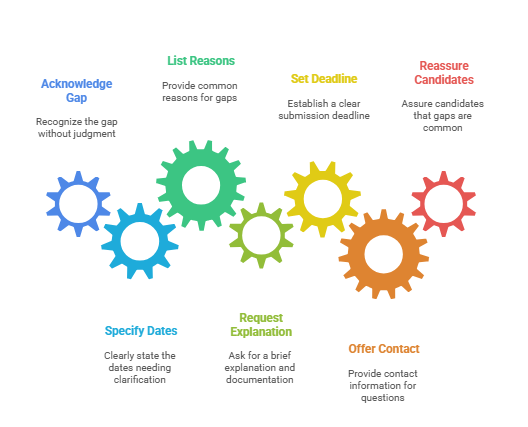
- Acknowledge the gap identified during verification without negative judgment
- Specify exact dates requiring clarification
- List common legitimate gap reasons without suggesting any are problematic
- Request brief explanation and supporting documentation if available
- Provide clear submission deadline, typically 5-7 business days
- Offer contact information for questions
- Reassure candidates that gaps are common
Response handling should protect candidate privacy while gathering necessary information. Medical gaps require only confirmation that health issues existed. Caregiving situations need validation of the responsibility. This balanced approach satisfies verification requirements without unnecessary personal disclosure.
Industry-Specific Considerations for Gap Evaluation
Different sectors face unique challenges in employment gap adjudication based on workforce characteristics, regulatory requirements, and operational needs. Healthcare employers must balance patient safety concerns with nurse and physician shortages. Experienced candidates remain valuable despite employment breaks when they maintain professional competence. Professional licensing status often matters more than continuous employment history.
Financial services institutions face stringent regulatory oversight regarding employee background checks. FINRA and SEC regulations require comprehensive job history documentation but don't prohibit hiring candidates with gaps. These sectors emphasize explaining gaps and confirming no undisclosed disciplinary actions occurred during unemployment periods. Enhanced due diligence protects institutions from regulatory violations while allowing consideration of qualified candidates.
| Industry | Primary Gap Concerns | Typical Acceptable Duration | Special Considerations |
| Healthcare | Clinical skill currency | 1-2 years with current license | May require refresher training |
| Financial Services | Regulatory compliance | No specific limit | Enhanced documentation requirements |
| Technology | Technical skill relevance | 2-3 years common | Self-directed learning valued |
| Education | Subject matter expertise | 1-3 years typical | Substitute teaching fills gaps |
| Retail/Hospitality | Availability and reliability | Frequent gaps common | Focus on recent history |
Technology sector attitudes toward employment gaps have evolved significantly. Startup experience, open-source project contributions, and skill development through online platforms increasingly replace traditional employment. Tech hiring managers often view entrepreneurial gaps positively as demonstrating initiative, risk tolerance, and practical experience.
Creating Effective Organizational Gap Policies
Written employment gap policies provide consistency, legal protection, and operational efficiency. Effective policies begin with clearly defined gap thresholds specifying minimum unemployment duration triggering review. Most organizations set this between 30 and 90 days, recognizing shorter periods often represent normal job transition timing.
Policy components should address multiple critical areas:
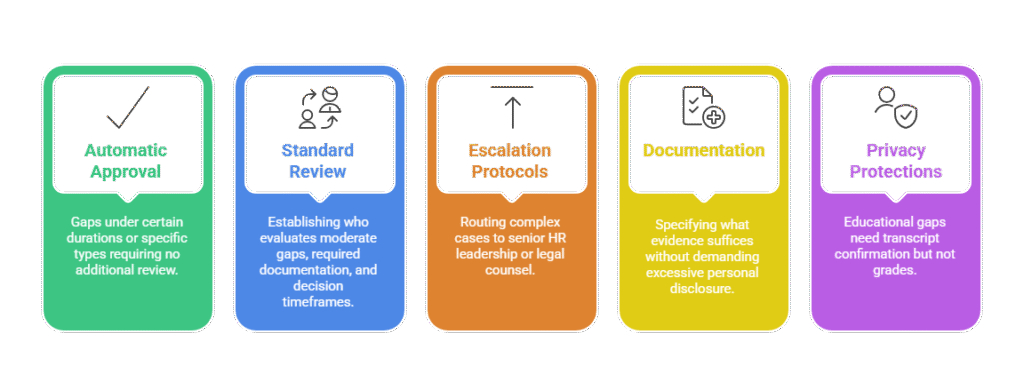
- Automatic approval thresholds: Gaps under certain durations (often 90 days) or specific types like documented education requiring no additional review.
- Standard review procedures: Establishing who evaluates moderate gaps, required documentation, and decision timeframes.
- Escalation protocols: Routing complex cases to senior HR leadership or legal counsel.
- Documentation requirements: Specifying what evidence suffices without demanding excessive personal disclosure.
- Privacy protections: Educational gaps need transcript confirmation but not grades; medical gaps require only provider confirmation without diagnosis specifics; freelance work needs references but not complete financial records.
These structured approaches prevent inconsistent application while maintaining flexibility for unusual circumstances. They respect candidate privacy while gathering necessary verification information.
Training Programs for Consistent Application
Training programs ensure consistent policy application across hiring managers and locations. Standardized training should cover legal compliance including FCRA requirements, anti-discrimination laws, and privacy protections. Policy application training addresses how to classify gaps and required documentation standards. Bias recognition components help identify unconscious assumptions that may disadvantage protected groups. Documentation practices training emphasizes recording decision rationale.
Organizations should develop comprehensive training materials including real-world case studies. These examples help reviewers understand how to apply policies in various scenarios. Role-playing exercises prepare staff for difficult conversations. Written reference guides provide quick access to key policy provisions. Well-trained staff make better decisions while reducing organizational liability.
Remote Work and Gig Economy Impact on Verification
The remote work revolution has complicated traditional employment verification methods that relied on physical workplace presence and standard payroll documentation. Remote employees may list addresses different from employer headquarters and report to managers in other states. Background screeners increasingly encounter these non-traditional patterns requiring adapted verification approaches.
Gig economy platforms have created an entire employment category that often appears as gaps in traditional screening. A candidate who drove for rideshare services or completed freelance projects through online marketplaces maintained continuous income. However, these arrangements typically lack traditional employer references or W-2 documentation. Standard background check procedures may incorrectly identify active work periods as unemployment gaps.
Verification adaptations for non-traditional work include:
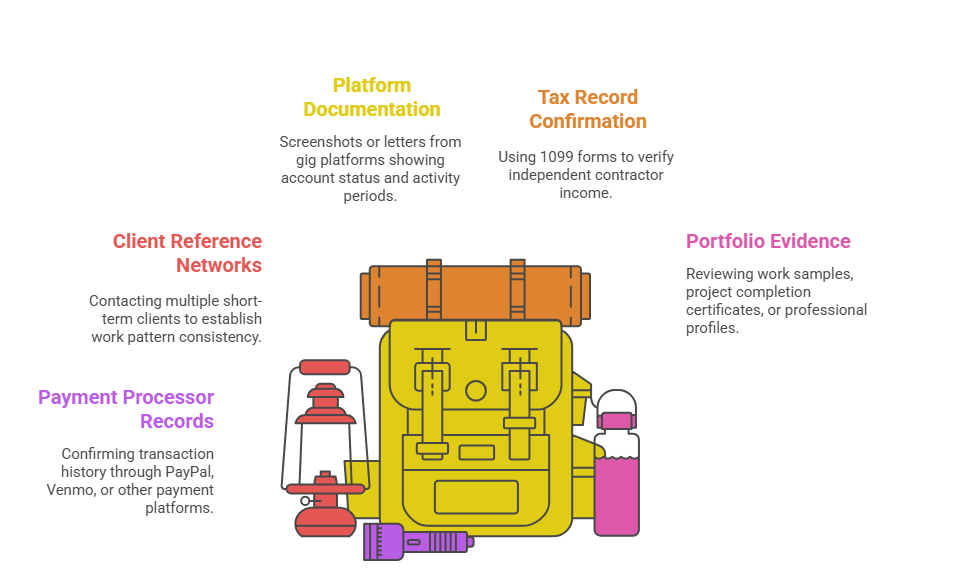
- Platform documentation: Accepting screenshots or letters from gig platforms showing account status and activity periods
- Tax record confirmation: Using 1099 forms to verify independent contractor income
- Client reference networks: Contacting multiple short-term clients to establish work pattern consistency
- Portfolio evidence: Reviewing work samples, project completion certificates, or professional profiles
- Payment processor records: Confirming transaction history through PayPal, Venmo, or other payment platforms
Organizations must update job applications to capture this work accurately. Adding fields for contract work, freelance projects, and gig economy participation helps candidates report complete work history.
Gap Explanations That Raise Additional Concerns
While most employment gaps have legitimate explanations, certain scenarios require enhanced scrutiny to protect organizational interests. Gaps accompanied by vague or inconsistent explanations may indicate attempts to conceal problematic circumstances. When candidates provide different gap reasons on applications versus during screening interviews, additional investigation becomes necessary.
Patterns suggesting intentional concealment include gaps coinciding with criminal records, professional license suspensions, or terminations for cause. Candidates who provide misleading gap explanations compound concerns. Transparency about difficult circumstances typically reflects better on candidates. Evasive explanations that emerge only when documentation contradicts initial claims raise red flags. Honesty remains the best approach even when discussing challenging situations.
Red flag indicators requiring deeper review include:
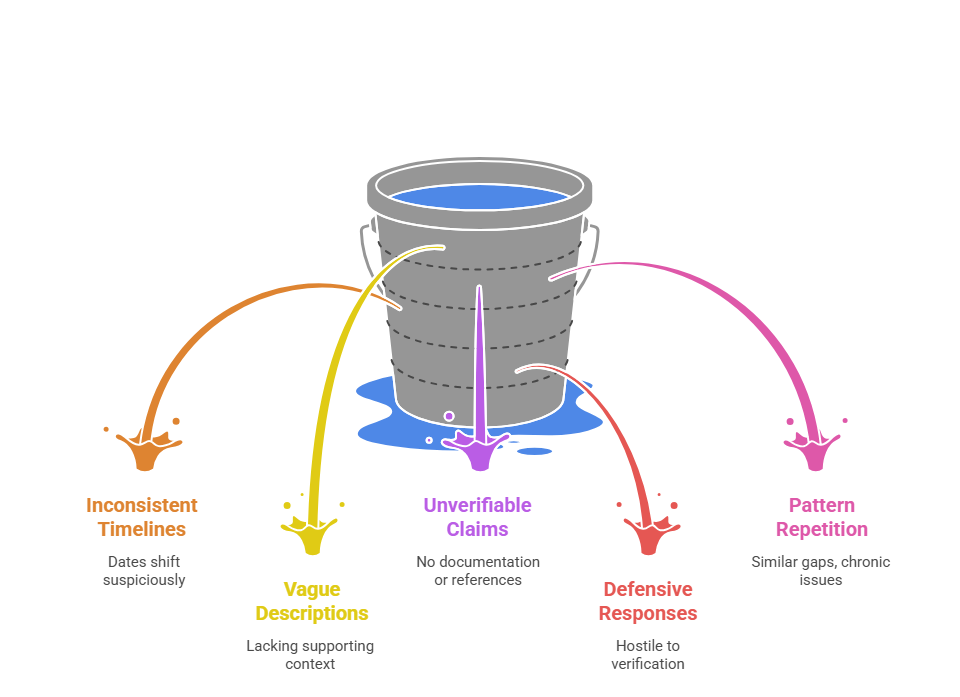
- Inconsistent timelines: Employment dates that shift between application, interview, and verification stages
- Vague descriptions: Explanations like "personal reasons" without supporting context
- Unverifiable claims: Freelance work or business ventures lacking documentation, references, or online presence
- Defensive responses: Hostile reactions to routine verification questions
- Pattern repetition: Multiple gaps with similar vague explanations suggesting chronic issues
Enhanced due diligence should follow structured protocols. Secondary verification attempts through alternative contacts help confirm or clarify findings. Expanded criminal record searches during gap periods may reveal undisclosed issues. Professional reference checks focusing on reliability provide additional perspective.
Decision-Making for Problematic Gaps
Organizations must document additional investigation steps and findings that either resolve or confirm initial concerns. This documentation protects against discrimination claims and ensures consistent treatment. Decision-makers should clearly articulate why certain gaps raised concerns, what additional information was sought, and how final hiring decisions were reached. Thorough record-keeping supports both legal compliance and fair treatment.
Decision-making should separate legitimate privacy boundaries from evasiveness. Candidates are entitled to keep personal medical details private while confirming health issues required for career breaks. Diagnosis disclosure is unnecessary. Similarly, caregiving situations need only general confirmation. The distinction lies between protecting privacy while providing honest, verifiable explanations versus offering deliberately vague information. Organizations that respect this balance make better decisions while maintaining candidate trust.
Preparing Candidates to Address Employment Gaps
Job seekers benefit from proactive gap preparation before background checks begin. Resume formatting should acknowledge rather than hide employment breaks. Brief explanatory notes provide context without excessive detail. Listing "Career Break for Family Caregiving" or "Sabbatical for Professional Development" between employment entries demonstrates transparency and prevents gaps from appearing to be concealment attempts.
Application completion requires attention to gap explanations from initial submission. When online forms request complete employment history, candidates should include all relevant activities including work that doesn't fit traditional categories. Noting freelance work, volunteer positions, or educational pursuits in chronological order creates comprehensive timelines, reducing background check complications and demonstrating thoroughness.
Documentation Preparation for Candidates

Documentation preparation streamlines verification processes and demonstrates professional readiness. Candidates should maintain organized records for easy access when verification requests arrive.
Essential documentation candidates should maintain includes:
- Previous employer information: Dates and contact information for all previous employers
- Tax documents: W-2s and 1099s covering all income sources
- Educational records: Academic transcripts and training certificates with completion dates
- Professional references: Contacts who can confirm freelance or contract work
- Gap documentation: General documentation for caregiving, medical, or other personal gaps confirming legitimacy
Interview preparation should include concise gap explanations emphasizing positive aspects and connecting experiences to current job readiness. Well-prepared candidates turn potential concerns into demonstrations of character and capability.
Balancing Thoroughness With Candidate Experience
Background screening processes significantly impact candidate perceptions. Overly intrusive verification questioning creates negative experiences that damage employer brands and reduce offer acceptance rates. The 2024 Talent Board Report found that 47% of candidates who felt background checks were handled poorly declined job offers. Organizations must carefully balance screening needs with respect for candidates.
Efficient processes respect candidate time while maintaining verification thoroughness. Automated systems that gather gap explanations through online portals reduce email volleys. Clear communication about verification timelines prevents candidates from wondering whether applications remain active. These operational improvements enhance experience without compromising screening quality and demonstrate respect for candidate time.
Transparency about how gap information will be used reduces candidate anxiety significantly. When organizations explain that gaps require documentation for comprehensive verification rather than automatic disqualification, candidates respond more openly. This honest communication prevents defensive reactions and improves information quality.
Collaborative Screening Approaches
Organizations leading in candidate experience design screening processes that feel collaborative rather than investigative. Framing employment verification as completing the candidate profile creates more positive interactions. Simple language shifts make substantial differences. Requesting information to "help us understand your complete background" differs from demanding candidates "explain employment gaps." These subtle adjustments improve candidate perception without sacrificing verification thoroughness.
Post-screening communication continues to shape candidate experience. Organizations should provide timely updates about screening progress and clearly communicate next steps. When gaps delay verification, explaining the situation maintains candidate engagement. Ongoing communication throughout the screening process demonstrates professionalism and respect.
Verification Challenges and Solutions
International employment histories present unique verification challenges. Foreign employers may not respond to verification requests. Language barriers, different business practices, or privacy regulations create obstacles. Some countries lack centralized employment databases that U.S. screeners typically access. These obstacles require creative verification approaches.
Solutions for international verification include requesting candidates provide translated employment letters with contact information. Using international background screening vendors with local expertise helps navigate foreign systems. Accepting alternative documentation like work permits, visa records, or passport stamps establishes physical presence. LinkedIn profiles with endorsements from international colleagues provide supplementary verification.
| Verification Method | Application | Reliability Level |
| LinkedIn recommendations | Professional network validation | Medium |
| Client references | Third-party performance confirmation | Medium-High |
| Business registration records | Confirming company existence | High |
| Tax documentation | Income verification | High |
| Professional portfolio | Work product demonstration | Medium |
Small business and startup employment poses similar verification difficulties. Many small companies lack dedicated HR departments. Startups may have closed. Business owners may be unreachable. These circumstances create legitimate verification barriers that don't reflect negatively on candidates. Screeners must develop alternative verification methods accommodating these realities.
Documentation Standards and Privacy Protection
Establishing clear documentation standards ensures consistency while protecting candidate privacy rights. Organizations should specify exactly what evidence satisfies verification requirements for each gap category. Educational gaps need transcripts confirming attendance dates. Medical situations require general confirmation from healthcare providers. Diagnosis details are unnecessary. Caregiving responsibilities can be validated through brief affidavits or letters.
Privacy protection requires careful handling of medical and personal information gathered during gap verification. HIPAA regulations restrict what medical information employers can request or retain. The Americans with Disabilities Act limits permissible disability-related inquiries. Family circumstances involve sensitive personal matters deserving discretion. Organizations must limit information requests to verification essentials and implement secure storage procedures. Encryption, access controls, and retention policies protect both candidates and organizations.
Best practices for privacy-compliant documentation include establishing minimum necessary standards for each gap type. Organizations should train screeners on permissible versus prohibited questions and implement secure document handling procedures. Regular audits ensure compliance with privacy requirements. Privacy protection serves mutual interests while maintaining screening effectiveness.
Measuring Adjudication Effectiveness
Organizations should regularly assess whether gap adjudication practices achieve intended outcomes. Metrics provide objective evaluation of policy effectiveness and identify improvement opportunities. Key performance indicators include time-to-hire for candidates with gaps, offer acceptance rates, and early turnover rates. These measurements show whether screening practices appropriately identify qualified candidates or create unnecessary barriers.
Demographic analysis ensures gap adjudication doesn't create disparate impact against protected classes. Organizations should track gap-related rejection rates across gender, race, age, and other protected categories. Disproportionate impacts require policy review and potential adjustment. This proactive monitoring prevents discrimination claims and ensures fair treatment. Regular audits demonstrate good faith compliance efforts.
Candidate feedback mechanisms provide valuable insights into screening experience quality. Post-process surveys ask candidates about gap explanation requests, communication clarity, and perceived fairness. Organizations that act on feedback demonstrate respect for candidate experience and benefit from enhanced employer brand reputation.
Continuous Policy Improvement
Continuous improvement processes incorporate metrics, demographic analysis, and candidate feedback into regular policy reviews. Annual assessment examines whether gap thresholds remain appropriate given workforce trends. Documentation requirements should balance verification needs against candidate burden. Organizations should evaluate whether current requirements create unnecessary obstacles. These regular reviews ensure policies remain effective, compliant, and aligned with organizational values.
Policy evolution should reflect changing workforce patterns and legal developments. As gig economy work becomes more prevalent, verification methods must adapt. Remote work normalization requires updated approaches to employment confirmation. Organizations committed to fair, effective screening treat policies as living documents updated regularly based on experience and changing circumstances.
Conclusion
Employment gap background check practices must evolve alongside changing workforce patterns to remain both effective and fair. Modern job history verification recognizes that career breaks for education, caregiving, entrepreneurship, and personal development are increasingly common and often enhance candidate value. Organizations that apply consistent, documented adjudication standards focusing on gap relevance, recency, and severity make better hiring decisions while protecting against discrimination claims. The most successful approaches combine technology-enabled efficiency with human judgment applying appropriate context to individual circumstances.
Frequently Asked Questions
What is considered an employment gap in a background check?
An employment gap is typically any period of 30 days or longer between jobs where a candidate was not engaged in traditional full-time employment. Background checks identify these gaps by comparing reported employment dates against records. Most screening policies focus on gaps exceeding 90 days for detailed review.
Do background checks show gaps in employment?
Yes, background checks examine employment timelines and identify periods where no traditional employment is recorded. However, modern screening recognizes that gaps may involve legitimate activities like freelancing, education, caregiving, or self-employment that don't always appear in conventional databases but represent continuous productive work.
Can you be denied a job because of employment gaps?
Employers can consider employment gaps when making hiring decisions, but FCRA requires providing adverse action notices and opportunity to explain circumstances before rejection. Organizations cannot use blanket policies that automatically disqualify candidates with gaps, as this may create discriminatory disparate impact.
How do I explain employment gaps on a background check?
Provide honest, concise explanations focusing on productive activities such as education, caregiving, freelancing, or health recovery. Documentation such as academic transcripts, tax records, or general confirmation of caregiving responsibilities strengthens explanations. Avoid excessive personal details while confirming legitimacy.
How far back do employment background checks go?
Most employment verification covers 7-10 years of work history, though some industries require longer periods. The depth depends on position level, industry regulations, and organizational policies. Higher-level positions and regulated industries typically require more extensive historical verification.
Do gig economy jobs count as employment on background checks?
Gig economy work should be reported as part of complete employment history, though it may not appear in traditional databases. Candidates should provide documentation such as 1099 tax forms, platform account confirmations, or client references to verify activity and prevent periods of active gig work from appearing as unexplained gaps.
Additional Resources
- EEOC Guidance on Use of Arrest and Conviction Records in Employment Decisions
https://www.eeoc.gov/laws/guidance/arrest-conviction - Federal Trade Commission: Using Consumer Reports for Employment Purposes
https://www.ftc.gov/business-guidance/resources/using-consumer-reports-employment-purposes - SHRM Background Checking: Conducting Criminal Background Checks
https://www.shrm.org/resourcesandtools/tools-and-samples/how-to-guides/pages/conductcriminalbackgroundchecks.aspx - Professional Background Screening Association Compliance Resources
https://www.psbassociation.org/compliance-resources - National Consumer Law Center: Fair Credit Reporting Act Guide
https://www.nclc.org/issues/fair-credit-reporting-act.html
Still have questions?
Get in touch with our team today for a personalized demo and discover how our tailored volume pricing and packages can drive results for your business!
How useful was this page?*
Note: your comments are anonymous. We use them to improve the website. Do not include any personal details.
Visit our FCRA Compliance Tool or leave a message here if you need a response.
From the blog Explore the GCheck Content Hub

Prescription Drugs That Show Up on Drug Tests: A Compliance Guide
4 Dec, 2025 • 18 min read
Seasonal Employee Background Checks: Protecting Your Business During Peak Hiring Periods
4 Dec, 2025 • 22 min read
Background Check for Volunteers vs Employees: Legal Frameworks and Screening Protocol Development
3 Dec, 2025 • 14 min readThe information provided in this article is for general informational and educational purposes only and should not be construed as legal advice or a substitute for consultation with qualified legal counsel. While we strive to ensure accuracy, employment screening laws and regulations—including but not limited to the Fair Credit Reporting Act (FCRA), Equal Employment Opportunity Commission (EEOC) guidelines, state and local ban-the-box laws, industry-specific requirements, and other applicable federal, state, and local statutes—are subject to frequent changes, varying interpretations, and jurisdiction-specific applications that may affect their implementation in your organization. Employers and screening decision-makers are solely responsible for ensuring their background check policies, procedures, and practices comply with all applicable laws and regulations relevant to their specific industry, location, and circumstances. We strongly recommend consulting with qualified employment law attorneys and compliance professionals before making hiring, tenant screening, or other decisions based on background check information.

